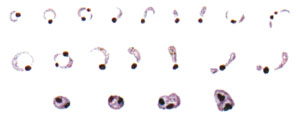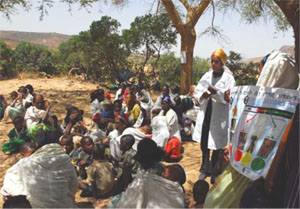Case definitions of priority diseases
You learned in Study Session 40 that a case definition is a set of standard criteria used to help you to separate true cases (those with the disease) from suspected cases that do not have the disease. Health workers in hospitals and Health Centres should use standard case definitions for reporting suspected priority diseases, i.e. a definition that has been agreed and should be used by all health professionals at higher levels within the country. Standard case definitions should be applied in the same way to all the persons examined.
Standard case definitions classify cases as confirmed or suspected. A confirmed case shows all the typical symptoms of a disease and the infectious agent or other cause has been positively identified in a laboratory investigation. For example, in a confirmed case of malaria, the patient shows symptoms typical of malaria, such as fever, headache and joint pain, the rapid diagnostic test (RDT) is positive, and laboratory investigation of a blood smear has confirmed that the person is infected with the Plasmodium parasites that cause malaria (Figure 41.2). On the other hand, a suspected case of malaria means that the person shows symptoms of malaria, but a laboratory investigation either has not been conducted yet, or has failed to find evidence of the parasite that causes malaria.

A community case definition is a simplified version of the standard case definition, adapted to suit the needs and resources of Health Extension Practitioners/Workers, community health volunteers, community members, traditional healers and birth attendants. It is useful to make a poster showing these definitions for the Health Post wall in the local language. Table 41.3 summarises community case definitions for some of the priority diseases in Ethiopia.
Table 41.3 Simplified community case definitions for use in identifying and reporting suspected priority diseases during community surveillance.
| Priority disease | Simplified community case definition |
|---|---|
| Acute watery diarrhoea in children aged under 5 years | Any child having loose stools within the last 24 hours, or showing danger signs of loss of fluid from the body (dehydration) |
| Cholera | Any person aged 5 years or older with lots of acute watery diarrhoea |
| Diarrhoea with blood and mucus | Any person with diarrhoea and visible blood and mucus in the stools |
| Epidemic typhus | Any person with sudden onset of headache and fever with chills, and general muscle pains, with or without spots (rash) |
| Guineaworm | Any person with a history of emergence of worms from the leg |
| Leprosy | Any person with loss of sensation and/or weakness in the muscles of the hands, feet or face; or loss of part of the hands or feet |
| Malaria | Any person with fever, or fever with headache, back pain, chills, sweats, muscle pain, nausea and vomiting |
| Measles | Any person with fever and spots (rash) |
| Meningitis | Any person with fever and neck stiffness |
| Neonatal tetanus | Any newborn who is normal at birth, but after two days becomes unable to suck or feed |
| Polio | Any acute paralytic disease |
| Plague | Any person with painful swelling(s) under the arms or in the groin area; in an area where plague is endemic, any person with a cough, chest pain and fever |
| Pneumonia | Any child less than 5 years of age with a cough and fast breathing, or difficulty in breathing |
| Relapsing fever | Any person with a fever that returns following a previous fever |
| Tuberculosis | Any person with a cough lasting three or more weeks |
| Typhoid fever | Any person with fever, constipation or diarrhoea, confusion (delirium) and with the body in a passively prone position (prostration) |
| Viral haemorrhagic fever | Any person who has an unexplained illness with fever and bleeding, or who died after an unexplained severe illness with fever and bleeding |
| Yellow fever | Any person with fever and yellowing in the white part of the eyes, or yellowing of the skin |
As a Health Extension Practitioner, you need to teach the community about these community case definitions of common diseases (Figure 41.3). The community can recognise and report common diseases to you if they understand these case definitions. The advantage of using community case definitions (instead of standard case definitions) is not only that they are simpler to understand. They are also 'broader' than standard case definitions, which means that more suspected cases will be identified using the community case definition, and fewer cases will be missed.
